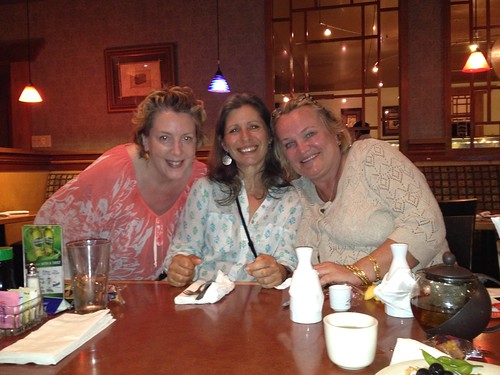I'm not a big fan of jittery camera work, which the film adaptation of
The Hunger Games uses in abundance, but I have to admit that it suited the story perfectly. If you have managed to skip the books or all of the hype surrounding the movie, it features sixteen year-old Katniss Everdeen (Jennifer Lawrence), who lives with her mother and sister Prim in District 12 in the country of Panem, what remains of North America. After a civil war, only 12 of 13 districts have survived, and they are kept under the tight control of a vengeful Capitol, led by a vindictive President Snow. To punish the districts and keep them in line the Capitol each year holds the Hunger Games, which pits 24 children, 2 per district, in a fight to the death, much like Roman gladiatorial combat. In just a few deft scenes the film was able to depict District 12, where Katniss, her childhood friend Gale, and acquaintance Peeta all hale from, giving the audience the feeling of what Appalachia might be like in a dystopian future.
 |
| Katniss and Peeta are forced to train for the arena |
"May the odds be ever in your favor."
Katniss is thrown for a loop when her younger sister Prim, only 12 years old, is chosen, and volunteers to be the female contestant for district 12 in her sister's place. She is rushed through a series of hasty goodbyes and a whirlwind exposure to the excesses of food and fashion that the Capitol enjoys, all the time being filmed constantly. Seeing the Capitol depicted onscreen, with all of its inhabitants' garish costumes and make-up was a huge contrast to the blood and guts arena. The casting was perfect down the line, with Jennifer Lawrence a standout as Katniss. Josh Hutcherson, who is frequently called on to play a bratty (
Zathura: A Space Adventure), even obnoxious (
Journey 2: The Mysterious Island) teen, was convincing as the sweeter, gentler Peeta, who knows that without Katniss he has no chance of winning in the arena.
I was wondering if the book's critiques of reality television and warfare would be able to survive such a hyped film — would the audience be guilty of being hungry for the Hunger Games? But the film was never exploitive of what the kids were put through. The fast-paced editing definitely sped past some of the deaths, but I don't think longer shots would have deepened their impact. On the reality television side, Stanley Tucci, was the perfect, oily host, Caesar Flickerman, who framed the contest in pre-Games touchy-feely interviews with the contestants and play-by-play, or death-by-death, coverage once the Games had begun.
 |
| Katniss watches Peeta yuk it up in his interview with Caesar Flickerman |
Although hardly seen, Donald Sutherland was menacing as the white rose-fancying President Snow. It may seem strange to some viewers how meekly the citizens of Panem take the fate of their children, and how those 24 teens immediately fall into the kill-or-be-killed gameplay rather than banding together to fight The Man. Caesar Flickerman introduces the 74th Hunger Games — after almost three quarters of a century, most of the fight seems to have gone out of the people — at least until Katniss lights a spark that will burn in the future.
By being herself, as stylist Cinna (Lenny Kravitz) advises her, combined with a bit of showbiz that mentor Haymitch (Woody Harrelson, perfectly cast as drunken past Hunger Games champion) coaches her to employ, she shows compassion for some of her fellow contestants and flouts the rules at crucial junctures in the Games, much to the dismay of the controlling President Snow. Kravitz, sporting Cinna's trademark gold eyeliner, only had a few scenes with Lawrence, but he managed to make their relationship seem as close and true as the characters in the book. He made me wonder if author Suzanne Collins had taken the story in a slightly different direction, Cinna might have blown the Peeta/Gale/Katniss love triangle to bits and Katniss could have run off with him.
 |
| Cinna wishes Katniss luck before she enters the arena |
But the main focus of the film is the arena, the Hunger Games, and they were as brutal as they were in the book, maybe more so, as the audience had to watch the bodies fall. The film actually helped make some of the other tributes, if not more relatable, at least more identifiable, as the book is told solely from Katniss's point of view. The film also took us behind-the-scenes in the Capitol's control room, showing us how many of the trials the kids suffered in the field originated there — something Katniss suspects in the book, but is too busy running from threats, trying to survive to give it much thought.
The movie clocked in at over two hours and 20 minutes, but it was fast-paced and exciting all the way. As much as I knew what was coming, after recently reading the books, it still was suspenseful and edge-of-seat scary at times. It was interesting to see how certain stand-out scenes were translated to the screen — the "tracker jacker" wasps, Katniss's alliance with District 11's young Rue, the fabulous, burning gowns designed by Cinna that helped make Katniss "the girl on fire."
 |
| Former District 12 champion Haymitch gives Katniss some support and advice before she heads off to the Hunger Games |
I saw
The Hunger Games in IMAX, with a full crowd, evenly mixed of adults and teens, many of us not chaperones. The filmakers were pretty smart to release it during spring break, when kids home from college could attend the screenings in packs, like the gaggle of teenage girls seated in the row behind me. I was more than a little freaked out to see some folks walking out after the film with young kids in tow. I have taken my eight year old to a few PG-13 movies myself —
Percy Jackson and the Olympians and the latest Tom Cruise
Mission Impossible movie. But
The Hunger Games doesn't have just a few scary scenes, or some shoot-em up chases. It features violence against children. That is the content of the whole film. It's not just a fantasy, but a deep, dark story set in a world not so incredibly different from our own. I wouldn't recommend my daughter seeing this one until she was thirteen, or mature enough to have read the books.
As much as
The Hunger Games isn't really about which of two guys a girl should end up with, old
Twilight habits die hard, as an audible and collective teenage girl sigh could be heard throughout the cinema (followed by quite a few adult giggles) when poor childhood friend Gale (Liam Hemsworth) watched Katniss kiss Peeta on the jumbo television screen back home. As much as both Peeta and Gale (and Cinna) think Katniss is hot stuff,
The Hunger Games is not a love story, but the story of a young girl, a hero, coming of age. It's great to see a brave and resourceful and female hero, and in IMAX.
The Hunger Games may be controversial, but in a good way. It gets people thinking and talking.


















